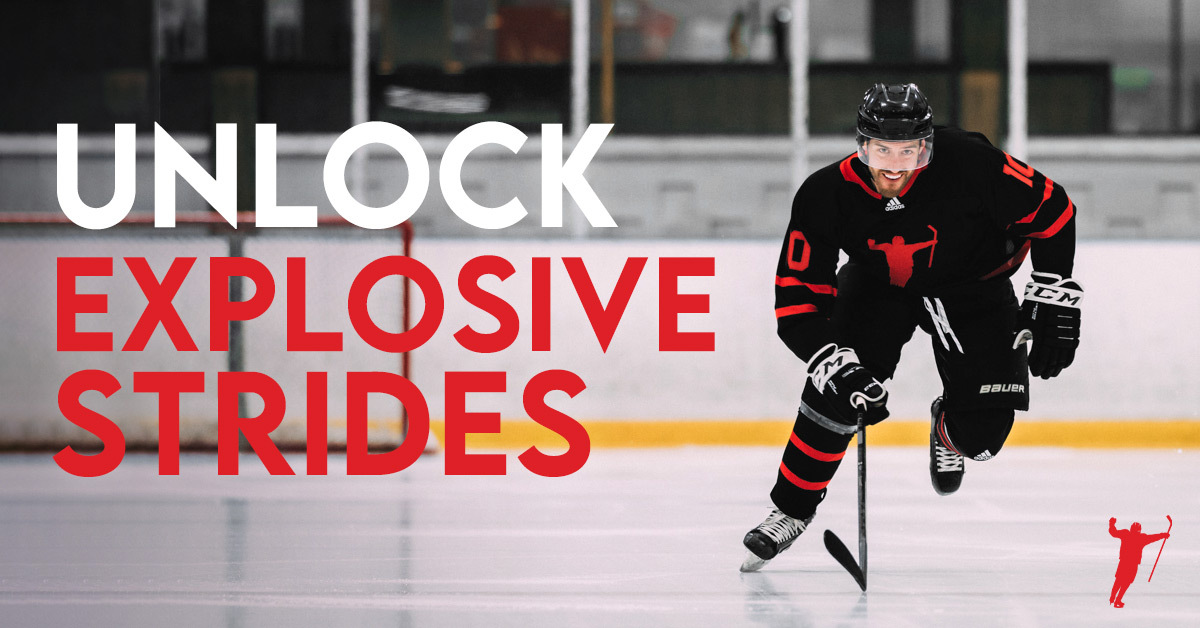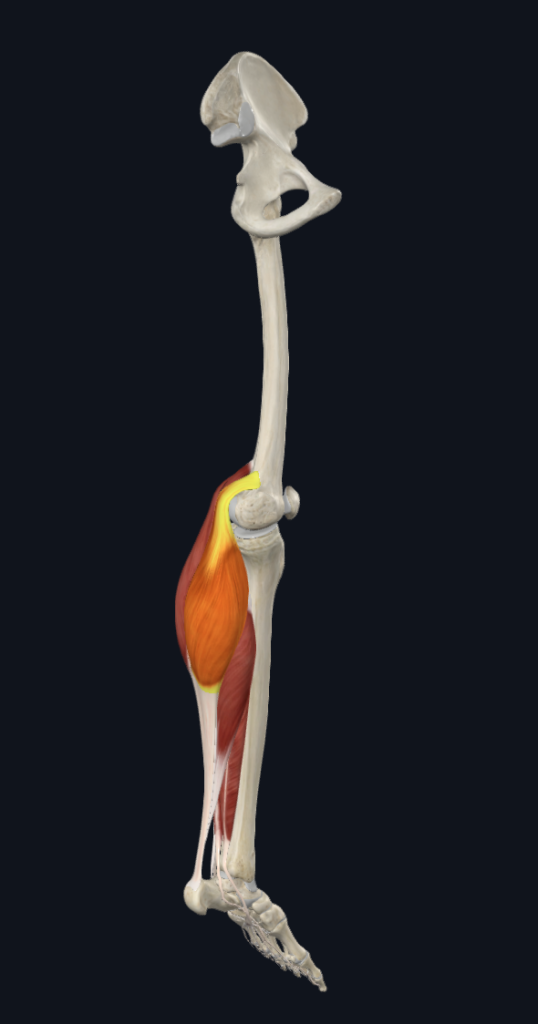Hockey players have always envied the muscular legs of players like Sidney Crosby or Marty St. Louis, propelling them forward in long, powerful strides. While many think of the quads, glutes, and hamstrings as the main drivers of power, most people overlook the usefulness of the calves completely.
How Calves Play a Role in Skating
Your calves are the unsung heroes of skating, providing the stability, mobility, and force needed for peak performance on the ice. They enable you to balance on your edges, sink into deeper skating positions, and transfer maximum power through your ankles to create explosive strides. Here’s why they matter:
Build a Stable Base
Imagine firing a cannon on solid ground versus firing it off from a canoe. The cannon shot on solid ground will travel farther, and the cannon will recover more quickly, ready to fire again. This is similar to the difference between producing force with a stable versus an unstable ankle.
The calf muscles help provide dynamic ankle stability during skating. When you perform skating strides, the calf muscles contract to create stiffness in the ankle joint, which maximizes force transfer from the larger leg muscles (like the quads and glutes) to the ground.
Without calf strength, the ankle joint might collapse or become too “loose” during these movements, reducing performance and increasing the risk of injury.
Deeper Skating Stance
Dorsiflexion—moving your foot upward toward your shin—is crucial in helping hockey players maintain an optimal knee bend and low body position while skating. This posture is essential for generating maximum power with each stride.
Tight or stiff calf muscles can restrict dorsiflexion by resisting the forward movement of the tibia over the foot. To unlock full skating potential, incorporating calf stretches and mobility exercises into your routine is vital for enhancing dorsiflexion and overall performance.
Powerful Stride Finish
Plantarflexion—pointing your toes downward away from your shin—is also an essential component in skating, as it is crucial for the final “toe-off” or “toe-flick” phase of a skating stride. As the ankle extends, it helps transfer force from the legs through the skate blade, propelling the player forward with maximum power.
The calf muscles play a central role in plantarflexion, as they are the primary muscles responsible for this movement.
How to Train Your Calves for Better Skating Performance
Properly training your calves through a full range of motion can enhance your strength, stability, power, and mobility, which are crucial for improving skating performance. Here’s how we can do it:
Create Power and Stability using Plyometrics
Plyometric exercises such as pogo jumps, single-leg hops, and bounds require strong ankle and foot stiffness to effectively transfer force from the larger muscles to the ice. Think of it as the difference between a powerful, coiled spring and a floppy, cooked noodle—stiffness in the right areas ensures explosive, efficient movement.
An often-overlooked strategy for hockey players is incorporating lateral and medial plyometric variations into their training. These movements are crucial for building the stability needed to control your inside and outside edges, which are heavily relied upon during crossovers, tight turns, and rapid direction changes. Prioritizing these exercises enhances edge control and overall skating agility.
Emphasize The Stretch for Dorsiflexion Mobility
When performing calf raises, hockey players should emphasize the stretch at the bottom of the movement to enhance dorsiflexion. Improved dorsiflexion allows for a deeper knee bend and forward lean, both essential for generating a powerful skating stride.
Think of calf raises as more than just a strengthening exercise—they’re a dynamic, weighted stretch that targets the calf muscles and lengthens the Achilles tendon, promoting greater flexibility and mobility. This increased range of motion translates directly to better skating mechanics.
It’s important to note that while standard calf raises on flat ground have their benefits, they may not provide the deep stretch needed to effectively improve mobility. To maximize mobility benefits, elevate your toes on a step or slant board to increase the range of motion and encourage deeper stretching. Alternatively, you can enhance the stretch by leaning your upper body slightly forward during the movement. This adjustment intensifies the stretch and activates the ankle joint more effectively (see videos below for demonstrations).
Incorporate a Powerful End Range of Motion
Triple extension—a movement pattern involving simultaneous extension of the hip, knee, and ankle—is fundamental to the most explosive actions in sports, such as sprinting, jumping, Olympic lifting, and, of course, skating.
In skating, the glutes and hamstrings drive hip extension, the quads power knee extension, and the calves are responsible for ankle extension (plantarflexion). Together, these muscles generate the force needed for powerful strides and efficient propulsion on the ice.
To maximize this power, it’s crucial to progressively load your calves with both weight and speed, just as you would with the larger muscles of the legs. Stronger, more explosive calves allow for more forceful toe-offs, increasing stride length and making each push more explosive.
For optimal results, focus on the full range of motion during calf raises. Just as the stretch at the bottom enhances dorsiflexion for a deeper skating stance, finishing as high on your toes as possible at the top builds strength in the range of motion directly used on the ice, translating to greater power and control during every stride.
Incorporating Calf Training Into Your Weekly Schedule
Organizing calf training in your training week is simple but requires some rules based on the type of training you’re doing:
Strength Training
- More stressful on the muscular system.
- Less stressful on the nervous system.
- A minimum of ~10 sets of exercise is needed for a muscle per week to increase hypertrophy.
- Due to the muscle damage that can be created, 48 hours of rest between bouts is a good rule of thumb.
With that in mind, you could add 3 sets of calf raises 3 times per week. That being said, if you’re still sore 48 hours after your session, that’s a sign that you’ve not recovered fully, and you should rest an additional 24-48 hours.
Plyometric Training
- Very important because of hockey’s emphasis on speed and power
- More stressful on the nervous system.
- Less stressful on the muscular system.
- You can train plyometrics daily, but it would be best if you alternated the volume using a high-low model.
The National Strength and Conditioning Association recommends 2-3 weekly plyometric sessions with 3-6 sets of 2-5 reps. This is the blueprint for your “high” days of the high-low model. You can start with 2 days per week of 3 sets of 3 reps. Then, over months, slowly increase volume to 3 days per week with 6 sets of 5 reps as your body adapts to the previous volume.
On the “low” days, you should cut the volume in half to minimize stress while stimulating the nervous system. This ensures the nervous system can fire efficiently for training sessions, practice, and/or games.
The goal with a high-low model is to accumulate all the stress on the high days so you can use the low days to truly recover. If you do high-stress days all week, you won’t be able to recover for games, making your on-ice performance suffer.
With all of that in mind, you should perform your calf strength training on the same day as your higher volume plyometric training during your high days so you can use the low days to recover.
Example Weekly Calf Training for a Hockey Player
Here is what a sample week could look like following a full dynamic warm-up:
Monday:
Pogo Jumps 3×5, Continuous Lateral Bound 3×3/side, 1-Leg DB Calf Raise: 3×6/side
Tuesday:
Squat Jumps 3×5
Wednesday:
1-Leg Medial Lateral Hurdle Hop 3×3/side, Alt. Split Squat Jump 3×3/side, Standing Calf Raise: 3×10
Thursday:
Squat Jumps 3×5
Friday:
Pogo Jumps 3×5, Continuous Lateral Bound 3×3/side, 1-Leg DB Calf Raise: 3×6/side
Saturday: Off
Sunday: Off
If you’re serious about becoming a better hockey player and want to learn how this training can fit into an in-depth plan, join the thousands of hockey players who have achieved results with our off-ice training programs.
Written by: Tim Lebbossiere
Assistant Performance Coach, Boston Bruins


